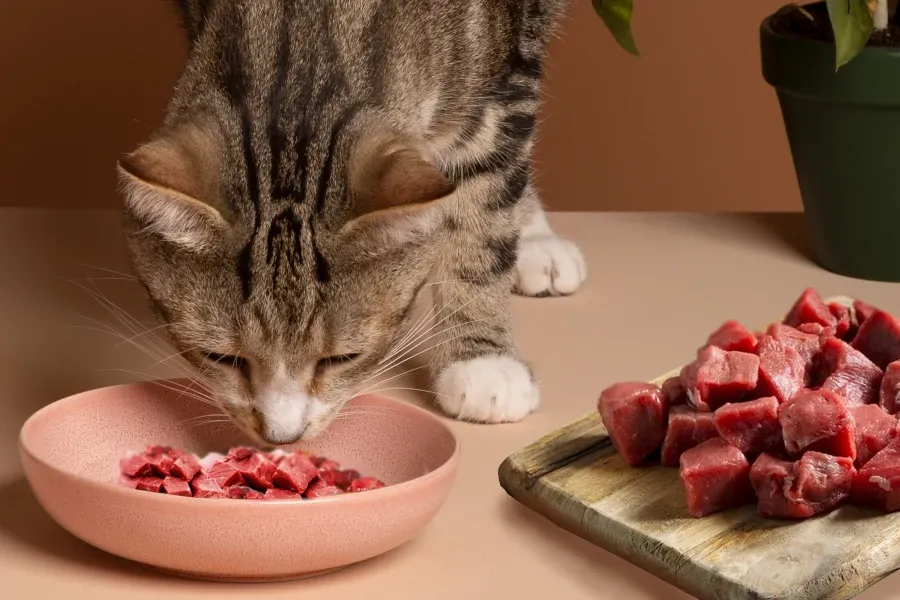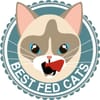The Top Benefits of Raw Feeding Your Cat (Part 1)
The top most notable benefits of raw feeding cats are looked at in this post, which forms part 1 of this compelling 2-part discussion. Nutritional, disease reversal and digestive benefits are focused on in this post.

This article discusses the most obvious benefits, backed by science and the experiences from veterinarians or seasoned raw feeding experts. It kicks off with a discussion of nutritional, health and digestibility benefits.
Part 2 continues the discussion by looking at two more very important, prominent benefits.
#1 Nutritional benefits
Cats are designed to obtain every nutrient they need from the prey they eat in the wild. Their physiology is finely tuned to these highly nutritious food sources.
Dr Diaz (DVM) explains that every nutrient in the cat’s natural diet is vital. They control the messaging of genes – like keys –locking and unlocking them for health, metabolism, weight management, appetite control and disease prevention1.
Mimicking the cat’s natural diet is important, as it will unlock the health benefits of natural feeding in a similar way. And with the right variety and combination of raw animal products, one can come very close to the cat’s natural diet.
...raw food analysis
To test the sufficiency of raw feeding, different raw feeding experts had their food scientifically analysed 2,3. Results showed that they met international feeding standards and surpassed minimum nutritional requirements.
...reinventing the mouse
Natascha Wille, raw feeding pioneer, went one step further. She had deer mice nutritionally analysed, followed by her raw feeding protocol. Her raw food came astonishingly close to the values of this feline prey staple 4.
So powerful are nutritional benefits from balanced raw food, that Dr William Pollak (DVM) describes how he reversed common diseases in 85% of dogs and cats with a raw diet alone 5, 6.
He concluded that the nutritional benefits from a raw diet awakens a level of shine and wellness in cats not seen with other diets.
Dr Lonsdale, veterinary surgeon, agrees that a carnivore appropriate raw diet is the single most important contribution to feline health and welfare 7.
#2 Radiant Health and Disease Reversal
One can not discuss the benefits of raw feeding without mentioning the research of Dr Pottenger, which dates back to the 1930s 8. His research remains one of the most compelling studies of dietary impact on the health of domestic cats.
It spanned multiple generations and a total of 600 cats were closely observed and recorded.
...radiant health observed
From his ten-year clinical study, Pottenger remarked how the health of the cats on his basic raw feeding protocol stood out above the rest.
By comparison, the raw fed cats were robust and muscular, friendly, active and agile. They were resistant to disease and infection, free from allergies and clear of parasites.
Their pelts were lustrous and they produced large litters of equally robust offspring. In one sentence, the raw fed cats and their offspring were flourishing and thriving.
...disease reversal demonstrated
Cats are also falling victim to the life-style diseases seen in humans on junk food diets – obesity, chronic inflammation, diabetes, cancer, allergies, autoimmune diseases, dental problems and more 9, 10, 11.
Dr Pollak (DVM) and Dr Tasi (DVM) describe how they reversed chronic disease with balanced raw feeding alone, without medication or any other veterinary intervention 5, 12. And these improvements were usually seen in relatively short span of time.
Similarly, other veterinarians also report marked improvement or reversal of obesity, diabetes, asthma, lower urinary tract problems, chronic vomiting and/or diarrhea, skin and ear problems as well as metabolic disease 3, 12, 13, 14.
...disease prevention
Dr Janković (DVM) concludes that there is no other diet or short-cut that can secure the same longevity and vibrant health for our cats as a balanced raw diet 15.
He feels that we can prevent costly acute and chronic diseases from manifesting in the first place, by feeding cats with greater care.
#3 Digestibility and improved digestive health
The faecal properties of cats on a raw diet very closely resemble that of other wild carnivores. Stools are less frequent, smaller, more compact, with a less challenging odour 3, 13.

...more effective absorption
The scientific explanation is that raw meat-based diets are highly digestible – far more so than any kibble or canned cat food 16.
Digestion is optimised by active enzymes present in raw animal tissue that facilitate improved absorption and diminish indigestible waste 3, 13.
The cat’s body more fully utilises moisture and nutrients from raw food with very little wastage – the way in which carnivores are engineered.
A research study confirmed that faecal output in cats on commercial foods are twice that of cats on a raw diet 17.
...digestibility research
Digestibility coefficient refers to the percentage of food that is absorbed during digestion. Foods with digestibility values of around 82% confirms both high digestibility and high food quality 16.
Notably, raw feeding studies have demonstrated digestibility ranging between 90% and 97% 17, 18, 19.
...an unpleasant side-effect
In contrast, commercial diets produce large, aerated and abnormally smelly stools. This is brought about by the higher volumes of indigestible, unused food that ferments in the intestines.
Putrefactive compounds from this fermentation are responsible for increased stool odour. Also, ammonia and branch-chain fatty acids from putrefying, unused amino acids are far higher with dry diets, confirming poor digestibility 19.
...associated health decline
The feeding of species-inappropriate, processed foods has been linked to a rise in inflammatory bowel disease and the increased loss of gut wall integrity in cats 20.
Also, enzyme loss from food processing stresses the pancreas and causes fatigue and enlargement of this vital organ. It often develops into pancreatitis – a very common and life-threatening result 14.
...improved digestive health
Because of its high digestibility, raw diets are often used as the first line of treatment in cats with inflammatory bowel disease 21, 22, 23, 24 and gastrointestinal dysfunction 25.
Raw food also often resolves inappetence and obesity in the process. However, feeding a raw diet can largely prevent these issues from happening in the first place by maintaining gastrointestinal health and preserving optimal functioning.
A balanced raw diet removes unnecessary fillers, carnivore inappropriate foods and indigestible ingredients from the diet that is so commonplace with dry and canned foods.
Removing these problematic ingredients often prompt immediate improvements in digestion and digestive health.
The next post looks at two more very important, equally impressive benefits from raw feeding your cat.


References
1 Diaz, G. (2017). Answers: What dry food does to your cat’s appetite. In Hare Today (Feline Nutrition Foundation Archive). Retrieved May 16, 2023, from https://hare-today.com/feline-nutrition/answers/answers-what-dry-food-does-to-your-cats-appetite
2 Dion, T. (2016). A Prey Model Raw diet analyzed: How does it stack up against AAFCO guidelines? In Cat Centric. Retrieved August 01, 2024, from https://catcentric.org/ 2016/05/23/prey-model-raw-diet-analysed-stack-aafco-guidelines/
3 Taylor, B. & Becker, K.S. (2013). Dr Becker's real food for healthy dogs and cats: simple homemade foods (4th ed). United States: Natural Pet Productions.
4 Wille, N. (2013). Reinventing the mouse – nutritional analysis of mice. In Feline Future. Retrieved August 01, 2024, from http://tcfeline.com/nutritional-analysis-of-mice/
5 Pollak, W. (2003-a). Elimination of common diseases in dogs and cats through diet alone.InFairfield Animal Hospital.Retrieved March 20, 2015 from https://drive.google.com/file/d/1pVBSekADqOWzXci0_AYVm1g_qr6DWyvp/view
6 Pollak, W. (2003-b). The Pollak Protocol for eliminating 85% of common disease in the dog and cat. InFairfield Animal Hospital.Retrieved March 20, 2015 from https://drive.google.com/file/d/1oFlWLa8Sfn4zBfgaYOHsFeCUdjwsKwWn/view
7 Lonsdale, T. (2006). Diet guide for domestic dogs and cats. In Raw Meaty Bones. Retrieved June 2, 2015, from http://www.rawmeatybones.com/ diet/exp-diet-guide.pdf
8 Pottenger F.M. (1983). Pottenger’s cats: A study in nutrition. La Mesa, California: Price-Pottenger Nutrition Foundation.
9 Zurich, L. (2010). Raw fed cats: Feeding cats a diet of whole raw foods based on nature's model, an illustrated companion guide. Self-published Ebook.
10 Freeland, J. (2012). The controversy between a raw food diet and a kibble diet: Is a raw food diet healthier for our Pets? Unpublished academic research report, American College of Applied Science, Florida, United States of America.
11 Fox, M.W., Hodgkins, M. & Smart, M.E. (2009). Not fit for a dog! The truth about manufactured cat and dog food. Fresno, California: Quill Driver Books.
12 Tasi, A. (2009). A veterinarian's view. In Hare Today (Feline Nutrition Foundation Archive). Retrieved August 08, 2024, from http://feline-notrition. org/health/a-vets-view-andrea-tasi-vmd
13 Pierson, L.A. (n.d.). Feeding your cat: Know the basics of feline nutrition. In Cat Info. Retrieved September 11, 2017, from http://catinfo.org/
14 Hofve, J. (2013). 10 Reasons why dry food is bad for cats & dogs. In Little Big Cat. Retrieved August 08, 2024, from https://littlebigcat.com/why-dry-food-is-bad-for-cats-and-dogs/
15 Janković, Z (n.d.). The complete diet for cats. In Equilibrium Malta. Retrieved August 6, 2024, from from https://www.vetmalta.com/natural-diet/the-complete-diet-for-cats
16 Little carnivore (2021). Benefits of raw feeding: The science. Retrieved on August 6, 2024, from https://thelittlecarnivore.com/en/blog/benefits-raw-feeding-cats-the-science
17 Kerr, K.R., Beloshapka, A.N, Morris, C.L., Parsons, C.M., Burke, S.L., Utterback, P.L. & Swanson, K.S. (2013). Evaluation of four raw meat diets using domestic cats, captive exotic felids, and cecectomized roosters. Journal of Animal Science, 91(1), 225 – 237; https://doi.org/10.2527/jas.2011-4835
18 Vester, B. M., Beloshapka, A.N., Middelbos, I.S., Burke, S.L., Dikeman, C.L., Simmons, L.G. & Swanson.K.S. (2010). Evaluation of nutrient digestibility and fecal characteristics of exotic felids fed horse- or beef-based diets: Use of the domestic cat as a model for exotic felids. Zoo Biology,29(4), 432 – 448; https://doi.org/10.1002/zoo.20275
19 Kerr, K. R., Vester, B.M., Morris, C.L., Liu, K.J. & Swanson, K.S. (2012). Apparent total tract energy and macronutrient digestibility and fecal fermentative end-product concentrations of domestic cats fed extruded, raw beef-based and cooked beef-based diets. Journal of Animal Science 90(2), 515 – 522; https://doi.org/10.2527/jas.2010-3266
20 Thomson, L. (2012). Inflammatory bowel disease: Nature and treatment. In Hare Today (Feline Nutrition Foundation Archive). Retrieved August 08, 2024, from https://hare-today.com/feline-nutrition/health/feline-inflammatory-bowel-disease-nature-and-treatment
21 Ugarte, C.E. (2003). The role of diet in feline inflammatory bowel disease. Unpublished Doctoral Thesis, Massey University, Palmerston North, New Zealand.
22 Guilford, W.G.(1996). Idiopathic inflammatory bowel disease. In W.G. Guilford, S.A. Center, D.R. Strombeck, D.A.Williams, & D.J. Meyer (Eds.). Strombeck's Small Animal Gastroenterology (pp 451 – 456). Philadelphia: WB Saunders.
23 Raw Feeding for IDB Cats (n.d.). What is feline inflammatory bowel disease? Retrieved July 29, 2019, from http://www.rawfeedingfor ibdcats.org/what-is-feline-ibd.html
24 Provost, L. (n.d). Raw Feeding Instructions. In IBD Kitties. Retrieved August 12, 2024, from https://www.ibdkitties.net/about-raw/
25 Stogdale, L. (2019). One veterinarian’s experience with owners who are feeding raw meat to their pets. Canadian Veterinary Journal, 60(6), 655 – 658; Open Access, retrieved August 12, 2024, from https://www.ncbi.nlm.nih.gov/pmc/articles/PMC6515799/
Disclaimer
The information provided on the Bestfedcats.com website is educational and informational. We are here to give guidance on how to feed a properly balanced raw diet. We also offer advice on how to improve the diet of the modern house cat. Please note that we are not veterinarians. We are not here to give veterinary advice. Best Fed Cats will not be held responsible for any adverse reactions to your cat based on the information on our website. The health of your cat depends entirely on you. We expect you to use your knowledge of your cats, their circumstances and their health – in conjunction with a trusted veterinarian – to determine if any advice provided on this site is appropriate for your cats.

